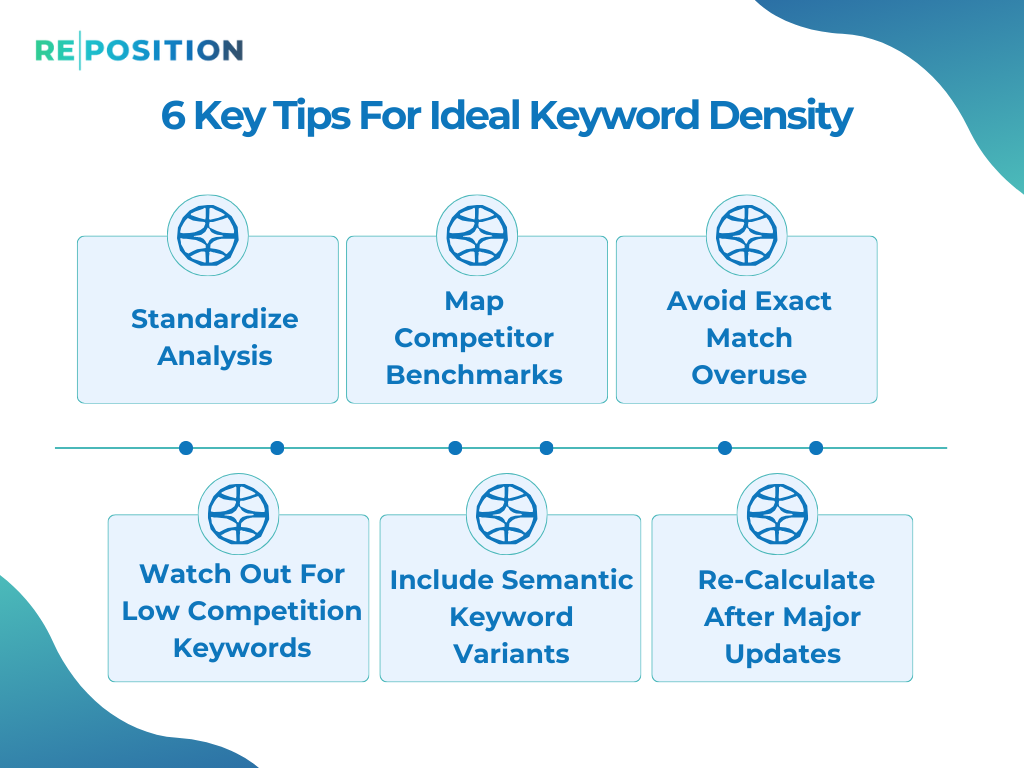Keyword optimization represents one of the most impactful SEO success factors for earning coveted top search engine rankings. Striking the right keyword density – the percentage of words on a page matching a target phrase – proves critical to ratings momentum.
Yet many brands still take a guesswork approach to density targets in content creation. Let us now see how to accurately calculate this crucial metric across pages to inform smarter optimization.
Keyword density refers to the percentage of words on a given page that match a specific keyword/phrase the page is targeting to rank for in search engines.
For example, if a page has 300 total words and uses a given keyword like “mobile phone plans” 3 times, the keyword density would be:
(Number of Keyword Occurrences / Total Number of Words) x 100
(3 / 300) x 100 = 1% density
Keyword density offers a quantified way to evaluate how prominently you have incorporated a target phrase within the body copy relative to recommended thresholds.

Getting keyword density within optimal ranges directly impacts search ranking potential thanks to two core factors:
Keyword Relevance Scoring
Pages with density percentages that demonstrate a focus on reflecting searcher intent around specific keywords tend to earn improved keyword relevance scores from engines like Google. This flows down to better overall quality ratings.
Preventing Over-Optimization Penalties
Excessively stuffing pages with keywords to chase density thresholds risks triggering spam filters and over-optimization penalties that bury pages deep in results. Optimizing density through natural incorporation balances relevance and quality.
So properly calculating and fine-tuning keyword density keeps your pages out of trouble while steering them toward higher relevance scores – the ingredients for ascension up the SERP ladder.
Industry best practices based on aggregate algorithm testing show ideal keyword density for SEO success typically falls between 1.5% and 3%.
So for a 1000-word post targeting a phrase like “social media marketing tips” you’d aim for between 15-30 total mentions across the full body copy.
The sweet spot range balances relevance with quality and demonstrates clear – but not aggressive – authority around the topic.
You also want to avoid exceeding 3-4% density as it raises overt optimization flags. And prevent density from slipping under 1% which fails to establish a strong theme association.
If you want to scientifically optimize keyword placement, you need to manually calculate density rather than guess.
Follow these steps:
Start by copying all main paragraph text on the page into a blank document editor like Word or Google Docs. Avoid including any supplemental text in headers, footers, navigation, or sidebars in the full-body text copy. The goal is to isolate just the core page content flowing copy that search engines index and evaluate.
With the body text compiled, use the built-in word count functionality in the text editor to tally the total words across all paragraphs on the given page. Note this number which represents the total indexable verbiage search engines assess page content and relevance from.
Next, use the editor’s find and replace tool to automatically surface the number of times your exact chosen keyword appears within the isolated body copy. For multi-word keyword phrases, be sure to use quotes around the full phrase for accurate match counting. Tally the total number of keyword instances discovered.
With the total body copy word count and exact keyword match total now available, plug each into this core keyword density formula.
(Number of Keyword Instances / Total Words) x 100
To continue the example above, if you ended up with 1200 total words across page body copy and 28 mentions of your target keyword “social media marketing”, you would calculate:
(28 / 1200) x 100 = 2.3% Density
Check the percentage yielded against industry recommendations for ideal density between 1.5% – 3% for balanced SEO impact. Finally, record density percentages by target keyword across priority pages to monitor if density falls within acceptable ranges or needs adjustment.
Repeating this scientific process for multiple target terms being tracked provides you immense visibility into precisely how prominent each keyword surfaces in copy relative to benchmarks.

Once you understand precisely how dense pages currently rank for target phrases, aim to adjust the density to balance relevance with over-optimization risks. Follow these best practices:
Tip 1 – Standardize Analysis
First Calculate density for multiple keywords across key pages to establish baseline averages before making major content changes. Get the lay of the land using the process above.
Tip 2 – Map Competitor Benchmarks
Determine what density percentages competitors currently rank above your target. Their splits offer helpful density guideposts to orient toward through revisions.
Tip 3 – Avoid Exact Match Overuse
Don’t solely rely on full phrase matches to accrue density as engines will see right through this tactic. Sprinkle in variations like long-tail blends with other words too.
Tip 4 – Watch Out For Low Competition Keywords
If targeting less competitive keywords, err closer to 2% vs 3% density maximums until ranked. This same guidance applies to hyper niche keywords with minimal search volume.
Tip 5 – Include Semantic Keyword Variants
Work semantic keyword variants into density counts that broaden overall topic coverage like synonym combinations. This builds authority depth.
Tip 6 – Re-Calculate After Major Updates
Whenever publishing sizeable content updates, rerun your density calculations to check you haven’t swung pages too far in either direction for keywords.
Learning precisely how to quantitatively calculate and tune keyword density across site pages empowers far smarter SEO optimization decision-making.
Rather than guessing at vague density targets, you gain actionable data to calibrate natural keyword incorporation aimed directly at visibility gains for core queries.
Interested in optimizing your keyword density through proven SEO best practices? Let Reposition Asia help you with a detailed density analysis plus content enhancement support. Let’s connect.